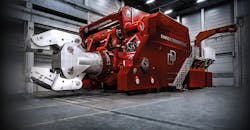DANGO & DIENENTHAL is introducing an energy-recovery function for its SSM line of open-die press manipulator machines. The ERS Energy Recovery System reduces energy demand of a moving drive by up to 70% and reduces the time needed to position forgings in a press by up to 30%. The first machine equipped with the ERS will be delivered soon to a customer in Germany, according to the developer.
When positioning forgings in an open-die press, the tongs of Dango & Dienenthal manipulators carry masses between 10 and 3,500 kN. Between the press strokes, the moving drive must accelerate and decelerate masses (including the workpiece) of up to 14,000 kN. During each deceleration action, the hydraulic fluid flows back into an accumulator from where it will be extracted for the next acceleration action. This reduces the manipulator’s total energy demand by 25 to 30%.
Dango & Dienenthal has adopted highly dynamic axial piston engines in place of proportional valves, with a number of advantages. As there is no loss due to throttling, the moving drive reaches its final speed earlier and will come to a halt faster. This results in 20-30% less time needed for the movements and less forging time per workpiece.
“In our forging manipulators the tongs and the moving drive form one common unit," explained Klaus Zillinger, hydraulics team manager. "Thus, the ERS now adds the advantage of lower energy consumption to the benefits derived from our simple and robust mechanical design."
He continued: "Additionally, the highly dynamic axial piston engines allow the manipulator to be controlled much more precisely and accurately than with the previously used proportional valves. Consequently, near-net-shape forging becomes more efficient, reducing subsequent finishing by machining or grinding.”
Replacing the proportional valves has dramatically reduced flow losses in the hydraulic system, and the hydraulic fluid heats up less. Consequently, approximately 20% less energy is needed for fluid cooling.
With a 25% lower installed power rating, the ERS achieves a significant increase in speed and a marked enhancement of operating precision. Also, running operating costs are reduced because axial piston engines require much less maintenance than systems based on proportional valves.
Learn more at www.dango-dienenthal.de
